 What we're learning
What we're learning at Polly's is that
learning is fun!
What we're learning about
Introduction
If you visit our nurseries it might look like the children are ‘just playing’ and you may be tempted to ask: “Is there any learning going on?” Our answer will be “Yes – and lots of it!”
Babies and young children develop and learn best through high-quality play and first-hand experiences, supported by warm and interested adults who know how to extend and develop children’s learning.
High quality play and first-hand experiences lead children to the richest and most enjoyable discovery and learning and this is what we want for our children.
In order to access high quality play and first-hand experiences children need three things. Firstly, they need the adults who support and teach them to know them well and to have a detailed knowledge of where they are in their learning. Secondly, they need adults around them who understand when (and when not) to join in with their play and who know how their play can be made more challenging or developed into other areas of learning. And, thirdly, children need the environment in which they play to be organised, planned and resourced in a way which engages them and actively promotes their progress.
On this page you will find examples of the high quality play and first-hand experiences provided at Polly’s and how these help to promote children’s learning and development.
Painting and mixing colours
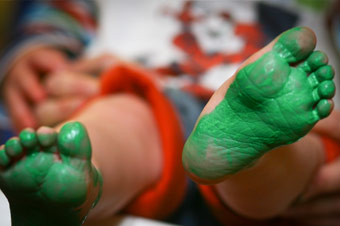 Painting and colour mixing help children to learn the names of colours and to learn about what happens when different colours are combined. Over time, and with lots of repetition, children learn how to mix exactly the shade and consistency they need to create the effect they have in mind.
Painting and colour mixing help children to learn the names of colours and to learn about what happens when different colours are combined. Over time, and with lots of repetition, children learn how to mix exactly the shade and consistency they need to create the effect they have in mind.
Painting is good for children’s physical development. They might do it sitting down at a table, or on the floor, or standing up at an easel, or outside on very large pieces of paper attached to our fence. We might be using our hands, fingers, feet, different sized brushes, rollers, sponges (or any number of other painting tools) and in the process we are developing our large and small motor skills and hand-eye coordination.
Painting also helps to support development of children’s problem solving, reasoning and numeracy skills. For example, sometimes we might paint an intended number of objects (e.g. a spider’s legs) and then count them to ensure we have painted the correct number. On other occasions, we might be learning to represent size and position in our painting (e.g. when we’re thinking about where our hair, eyes and nose should go on our self-portraits).
Painting is also good for children’s personal, social and emotional development, giving them freedom to make choices and decisions (about which colours and tools they’d like to use and about the subject of their painting etc). Our older children are encouraged to independently choose and gather their own resources for painting and also to put on and take off their own aprons.
Small world play
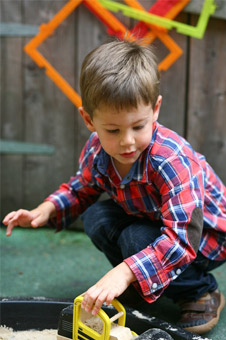 When it is done well, small world play offers children incredibly engaging and exciting chances to explore real and imagined worlds... in miniature!
When it is done well, small world play offers children incredibly engaging and exciting chances to explore real and imagined worlds... in miniature!
Acting out stories and ideas with small equipment (animals, people, dinosaurs, vehicles etc) is good for children’s personal, social and emotional development because it affords them opportunities to be in control and to decide exactly what, when and how things are going to happen. It also helps them to reflect on their feelings and experiences.
Small world play helps children to develop and extend their language as they talk about what they are doing, make sounds to accompany the action or develop a story with their friends.
And, as they travel to the moon or to the North Pole, go on safari or live the life of a princess, a pirate or a farmer, small world play is also helping children to develop their imagination and creativity.
Block play
We love the fact that blocks don’t have a fixed purpose, that they don’t do just one ‘thing’ as so many toys seem to these days. This means that block play offers children a very high degree of creative freedom, inviting them to explore, discover and apply new possibilities. Blocks can be used to create bear caves, roads, pirate ships, runways, train tracks, houses, farms, castles, bridges, forests and millions of other things. In fact blocks can be anything children want them to be.
Block play is good for children’s mathematical development. Blocks come in different shapes and sizes which means children have opportunities to learn and use correct mathematical terms to describe shapes and to use comparative terms (longer, shorter etc). Children can sort and match the blocks and count them for a purpose (how many blocks do you have in your tower? etc).
Block play accommodates the three main types of play: solitary, parallel and collaborative. Collaborative play is good for children’s personal, social and emotional development because it provides chances for them to learn to listen and respond to each other’s views and ideas and to negotiate.
Block play is also good for children’s physical development. When children are building with blocks, picking them up, moving them around and placing them exactly where they want them to go, this is helping to develop their gross and fine motor skills.
Sand and water play
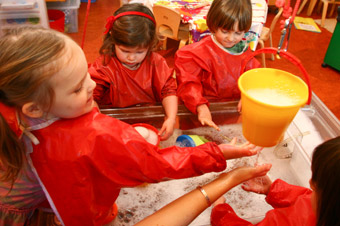 Sand and water are fabulously versatile natural materials which children love touching and playing with. We use sand in lots of ways including digging and building, for role play (at the seaside, a builder’s yard etc) for exploring our hand and foot prints, for writing our names in with our fingers, for small world play, for making a wormery. We use water for floating and sinking investigations, to bath our dolls, for role playing at the car wash, to water the vegetables we are growing and for washing our own hands!
Sand and water are fabulously versatile natural materials which children love touching and playing with. We use sand in lots of ways including digging and building, for role play (at the seaside, a builder’s yard etc) for exploring our hand and foot prints, for writing our names in with our fingers, for small world play, for making a wormery. We use water for floating and sinking investigations, to bath our dolls, for role playing at the car wash, to water the vegetables we are growing and for washing our own hands!
As well as being great fun, sand and water play offer valuable learning opportunities. So, when children fill and empty different sized containers they are also learning about weight and capacity. When they play with ice cubes in warm water they are learning about cause and effect. When children play with sand they are learning that it can be divided, and added and subtracted and that more is heavier and less is lighter.
When children are add water to sand they learn that the way the sand looks and feels has changed but, later, when it has dried, they discover that it has changed back to how it looked and felt before. On a sunny day, children might discover that although the surface of the sand is warm when they dig down they find it is cool. On a cold winter morning they might discover that the water we purposely left out last night has frozen solid and we talk about how this has happened.
Outdoor play
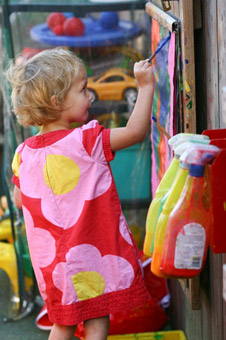 As adults it’s easy for us to think about the benefits of outdoor play in terms of children’s physical development and the general feeling of well-being that results from enjoying plenty of fresh air. But there is so much more!
As adults it’s easy for us to think about the benefits of outdoor play in terms of children’s physical development and the general feeling of well-being that results from enjoying plenty of fresh air. But there is so much more!
Our outdoor play areas are equipped with small scale climbing equipment, cars and bikes, a range of balls and bats, sand and water, large scale construction toys, structures for imaginative play and cosy, thatched roofed spaces in which children can relax, look at a book or talk with their friends.
We like to plant and grow fruit, vegetables and herbs and we learn about what plants need to help them grow. We enjoy digging in soil, exploring how it feels and finding mini beasts that live in it. Being outside helps us to learn about the changing seasons, different kinds of weather, the life cycle of things and the importance of exercise.
Group games and activities outdoors help to develop children’s listening skills, their ability to follow verbal instructions and their understanding of how to play collaboratively. When using our cars and bikes and other individual equipment children are also learning how to share and take turns nicely.
There are lots of fun opportunities at Polly’s for mark making outside and children’s emergent writing is supported by easels, chalk boards, paper and writing tools for role play and paintbrushes with pots of water they can use to ‘paint’ the fence.
Heuristic play
Heuristic play involves providing young children with a large number of different kinds of carefully chosen objects from the real world (rather than toys) to play with freely.
This kind of play is open-ended by which we mean that there is no pre-planned or specific learning intention. The idea is to give children an extended period of time to explore and investigate the objects, to find out what can be done with them and to make enjoyable discoveries!
It is very important that children lead their own learning during heuristic play. They should make their own choices and be able to explore and play without interference or guidance from adults. Our role is to make sure there are lots of interesting resources, plenty of time to explore them and a lovely relaxed, happy and emotionally secure environment for the children to play in.
Heuristic play supports the personal, social and emotional development of very young children because it allows them to choose what to play with, to control the amount of time they spend exploring an object and also to return to the objects that interest them most - perhaps because of the sounds they can make with them, how the objects feel or what can be done with them.
When playing in this way, children will often purposely repeat an action several times (for example by fitting one item into another) to test the result and this helps to strengthen their cognitive development. Heuristic play is also good for children’s physical development because it promotes their fine motor control and hand-eye coordination.
As adults, our main role during heuristic play is to closely observe what the children are doing with the objects they’re playing with. This helps us to identify schemas in children’s play. Schemas are patterns of behaviour that children demonstrate when they are exploring objects and trying to find out how things work.
Here are some of the common schemas we have observed in our children during heuristic play and other forms of play at the nursery:
- Containing – putting themselves or objects into different containers
- Enveloping – covering themselves, objects or a space
- Positioning – classifying and sequencing objects in a particular order
- Rotation – turning, twisting or rolling themselves or objects
- Transporting – moving objects from one place to another
It is important that we, as practitioners, understand schemas in children’s play because they can help us to become more effective in supporting children’s learning and development. The premise is that our input will be more effective if it is in tune with children’s interests and their natural development inclinations at any given time.
So, for example, if we observed repeated patterns of behaviour in a child’s play which indicated a positioning schema we could then plan appealing, age-appropriate opportunities to build on this.
Examples might include planning activities that involve sorting everyday objects, using positional language (in front, behind etc), comparative terms (tallest, shortest etc), ordinal numbers (e.g. first, second, third) and activities that enable the child to explore colour, shape, size, pattern and sequencing.
Emergent writing
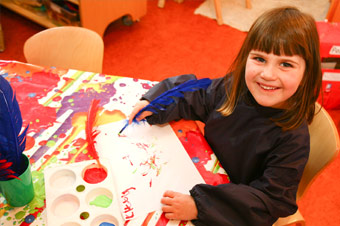 Children at Polly’s are given lots of opportunities to explore and experiment with writing and mark-making.
Children at Polly’s are given lots of opportunities to explore and experiment with writing and mark-making.
In our pre-school classrooms there are dedicated mark-making areas equipped with paper, mark-making tools (pencils, crayons, chalks, pens etc) and other equipment such as a hole punch, paper clips, stapler, glue and tape.
Children are also encouraged and supported to mark-make in other areas of daily life at the nursery, such as role play (to write a shopping list or an invitation to a birthday party etc). Older children write their name on labels to let everyone know that a model they have been working on is work-in-progress and should be kept, rather than tidied away. Children write their names on their artwork and they help to make signs and notices to display in the nursery. We make ‘All about me’ books which include children’s mark-making and emergent writing. We often take pencils, paper and clipboards with us on our walks so that the children can make a record of particular things they have seen or heard. These, and other early writing experiences at the nursery, help children to learn that marks have meaning and that writing has a purpose.
We help children to learn to use a tripod grip through the use of very small pieces of chalk and crayon and we support their interest in representing the words they say on paper by teaching letter names and sounds. We often make a start on this by focusing on the letters most important to the child in his or her first name (e.g. the ‘B’ in Bella) and then move on to teach the names and sounds of other letters in their name. When teaching letters and sounds at the nursery we use the same methods that are used in the Reception class at the Primary school your child will go on to.
Stories and books
 Children learn language by hearing it and by saying it and so it is very important that children are cared for in an environment where there are lots of opportunities to hear rich and engaging language.
Children learn language by hearing it and by saying it and so it is very important that children are cared for in an environment where there are lots of opportunities to hear rich and engaging language.
Stories and books (and songs, rhymes and poems) are staple elements of our daily life at the nursery and they make a valuable contribution towards helping us to create a sociable and language-rich environment for children.
Stories and books help children to develop their speaking and listening skills from the very earliest stages. From babies gleefully vocalising their response to pictures they see in board books, to toddlers joining in with repeated refrains in rhymes and stories, to our pre-schoolers who are able to talk at length about the characters, illustrations and main events in a story.
Stories help children to experience alliteration, rhyme and initial letter sounds in words. They provide opportunities to join in with counting and to recognise colours and numbers in print. Stories expand children’s vocabulary and they support the development of children’s language for thinking, for example about what has happened in a story, why it has happened and how the characters might be feeling. Non-fiction books at the nursery help children to support and develop their interests and to learn new facts.
Children must have stories. Stories perform a crucial role in helping children to acquire language and they significantly enhance children’s creativity and imagination. What's more, there aren’t too many things that can beat snuggling up and listening to a good story are there!?